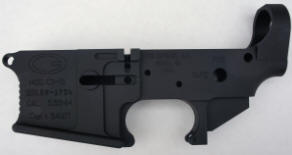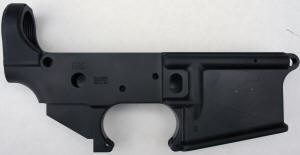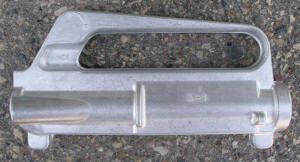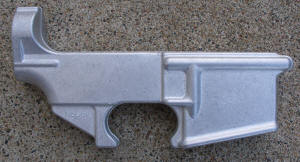Machined Versus Forged and
6061-T6 Versus 7075-T6 Upper & Lower Receivers
July 7, 2012
Based on reading several internet forums, it seems like there is some uncertainty (and maybe a little misinformation) on what are the superior process and materials to use when making an AR style upper or lower receiver. The two main process are Machined (from billet) and Forged receivers, and these two manufacturing processes can come in two different materials which are 6061-T6 and 7075-T6. Before I make a call on which I believe is the better process and material, let's first take a close look at the details of these processes and the material properties for each.
Machined
For the purposes of this article and with reference to upper and lower receivers, "Machined" refers to a part that has all of its features machined into it the final part and the initial part starts out as a featureless "billet" of material. Billets are typically pieces of material that have a square or round cross section that is less that 36 square inches. Billets are produced by various methods such as continuous casting, extrusion, rolling or drawing. Billets are also referred to as bar stock.
Forged
Various material such as steel and aluminum can be forged. In the forging process, to make a receiver for example, an aluminum ingot or billet is heated to between 800 and 900 degrees Fahrenheit depending on the alloy and then pressed (forged) in a precision-machined closed die press to produce the final shape. One of the key advantages of a forged part is that it requires less machining since it is already near or at the final shape/dimension after the forging process. These next two photos from NoDak Spud LLC® show examples of forged upper and lower receivers prior to any final machining.
In the table below, I have tried to list the key mechanical properties for billet (bar) and forged material for both 7075-T6 and 6061-T6 aluminum alloys. The data listed should give you a good idea on the tensile, compressive, shear and bearing strengths of these materials.
Table 1 - Material Properties
| Alloy and Temper |
Form | Thickness | Material Properties* (KSI unless noted) | Page* | |||||||
| Ultimate Tensile Strength Ftu |
Yield Tensile Strength Fty |
Yield Comp. Strength Fcy |
Ultimate Shear Strength Fsu |
Ultimate Bearing Strength Fbru e/D=1.5 |
Yield Bearing Strength Fbry e/D=1.5 |
Modulus of Elasticity E x103 |
Density ω (lb/in3) |
||||
| 7075-T6 | Bar, Rod & Shapes: Rolled, Drawing or Cold Finished |
1.001 - 2.000 | 77 | 66 | 64 | 46 | 100 | 86 | 10.3 | 0.101 | 3-380 |
| 7075-T6 | Die Forging | 1.001 - 2.000 | 74 | 63 | 66 | 43 | 104 | 82 | 10.0 | 0.101 | 3-381 |
| 6061-T6 | Extruded Bar, Rod & Shapes | 1.001 - 6.500 | 38 | 35 | 34 | 19 | 52 | 42 | 9.9 | 0.098 | 3-272 |
| 6061-T6 | Die Forging | ≤ 4.000 | 38 | 35 | 36 | 25 | 61 | 54 | 9.9 | 0.098 | 3-270 |
| * - Data taken from DOT/FAR/AR-MMPDS-01 Metallic Materials Properties Development & Standardization, 31 January 2003 | |||||||||||
Machined Versus Forged Upper and Lower Receivers
You can find many debates/discussions on this subject at various internet forums. Table 1 above shows the material properties for billet (bar) and forged materials and overall the material properties are similar for a given alloy (7075 or 6061) and temper (T6). Although there are slight differences in strength, in general I would say that their strengths are so similar that you could call the billet (bar) and forged materials equal. Some may argue that the continuous grain structure of a forged part adds to the strength and I agree that grain structure can come into play, but for the purposes of a firearm receiver, the strength of billet (bar) and forged material is so similar that they should be considered equal. The more significant differences are the cost to manufacture (machine) and the final finish of the part. Once a manufacturer has tooled up to make a forged part, the total cost to make the part can be significantly less due to the minimum amount of machining required, especially if they are making many parts so they can divide the up front costs of the precision dies by many parts. Remember that a precision forged part can be produced to the final dimension and only require final machining at critical locations. On the other hand, a fully machined part from a billet of material has the potential of a greater quality finish with sharp crisp details and also gives the manufacturer the ability to provide a variety of receivers that vary certain features like forward assist, case deflector, trigger guard, magazine well, magazine release fence, etc.
The photos below show an example of two C3 Defense machined and forged lower receivers. You can click on these photos to bring up high resolution photo showing the details. You should be able to see the sharp crisp lines of the machined part and the smooth rounded surfaces of the forged part. Also notice the price difference between these two parts. Not having photos of the other sides of these receivers, I'm not 100% sure if I'm truly comparing apples to apples with these two receivers, but you can see there is a significant difference in cost and the forged lower receiver is much cheaper.
Figure 3 -
Machined (MSRP $199)
Figure 4 -
Forged (MSRP $108)


So which is better; a machined or a forged lower receiver? For the value minded person like myself, I would say the forged part is better for my budget and there is no significant difference in strength. If you are not as concerned about price and prefer the crisp lines and potentially an overall better surface finish, or if you are looking for certain features on the receiver, then I would recommend a receiver fully machined from a billet of material. Depending on the manufacturer, you may not have a choice because they may offer only one style of receiver, so this question may be more applicable when comparing receivers from various different manufacturers.
6061-T6 Versus 7075-T6 Upper and Lower Receivers
If you take a look at Table 1 above, you can see that 7075-T6 has nearly twice the strength of 6061-T6. Because strength also relates to hardness, 7075-T6 aluminum has a Brinell hardness of 150 and 6061-T6 aluminum has a Brinell hardness of 95. Clearly, the 7075-T6 alloy is stronger and harder than the 6061-T6 alloy and would be the better material for making upper and lower receivers. Luckily, most receivers today are made from 7075-T6. Although scarce, you can still find 6061-T6 upper and lower receivers on the market today which begs the question how much strength do you really need in an upper and lower receiver? The answer depends on how you intend to use your firearm. If you are just a plinker and baby your firearms, strength is probably not as much of an issue. If you have the potential to put your firearm under some realistic usage situations, then stronger is clearly better because you don't know what types of real stresses other than normal firing that you may put on your weapon.
Bottom Line:
If you are purchasing a new AR style rifle or receivers, you should make sure the receivers are made from 7075-T6 aluminum alloy material. Luckily most currently manufactured receivers are made from this aluminum alloy so this shouldn't be a problem. Don't be swayed into thinking that forged receivers are significantly stronger than their fully machined counterparts because there is little real difference in the material strengths. As long as the material is 7075-T6, you should make your decision on which to purchase (machined or forged) based on the cost, looks and features on the rifle or receivers.
Feedback is always welcome and if you see anything that is in error or something that could/should be added, send me an email at editor@gunsumerreports.com.
Or
If you would like to be notified about future Gunsumer Reports reviews via Facebook, make sure "You Like This" by clicking the Facebook "Like" button at the bottom or top of this page. If it already says "You Like This" beside the button, clicking it again will uncheck the "Like" status and you will not be notified.
| Share on Facebook | |
© 2010, 2011, 2012, 2013, 2014, 2015, 2016, 2017, 2018, 2019, 2020, 2021, 2022, 2023 & 2024 Gunsumer Reports™, All rights reserved.
FTC Disclosure


